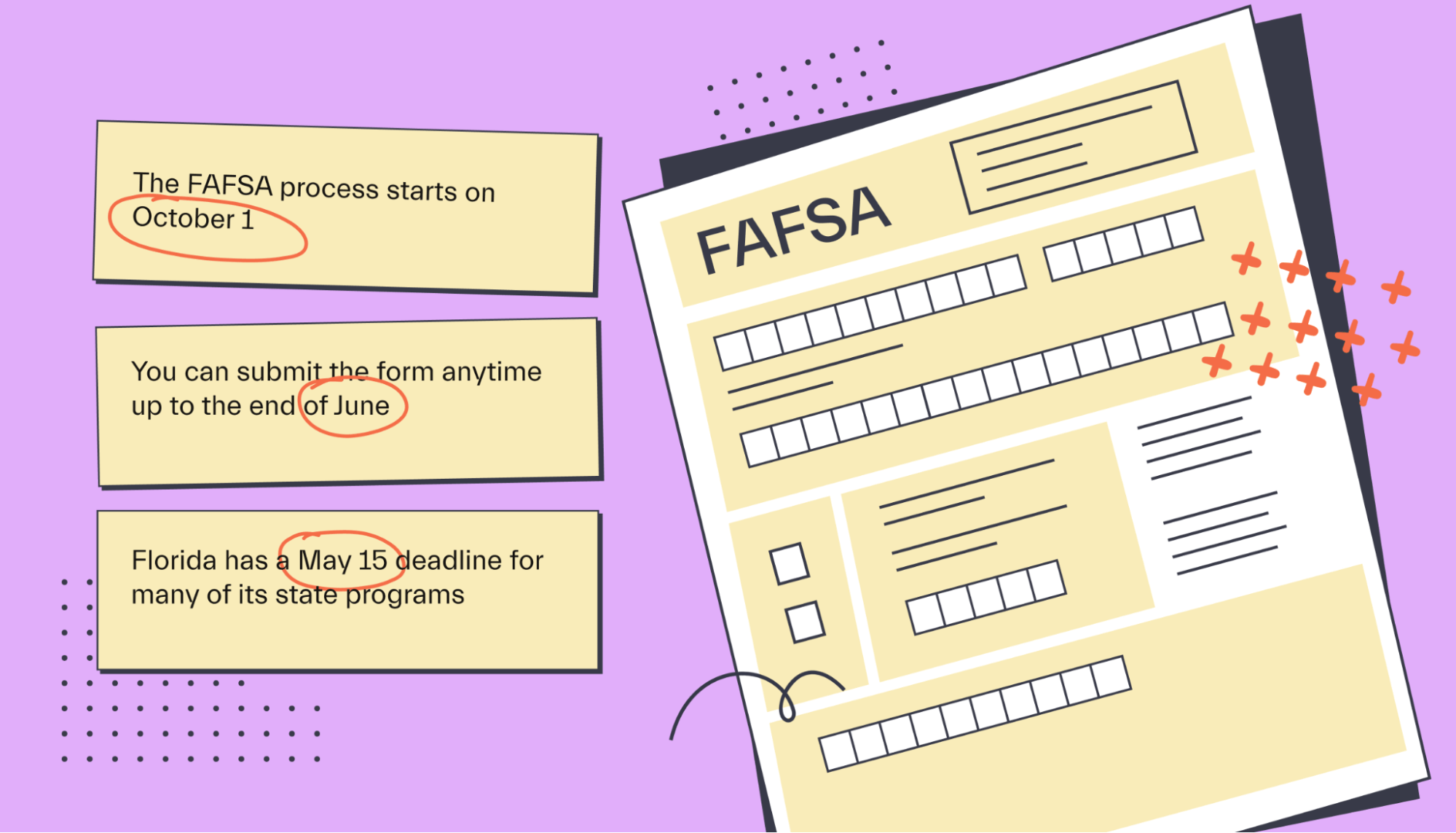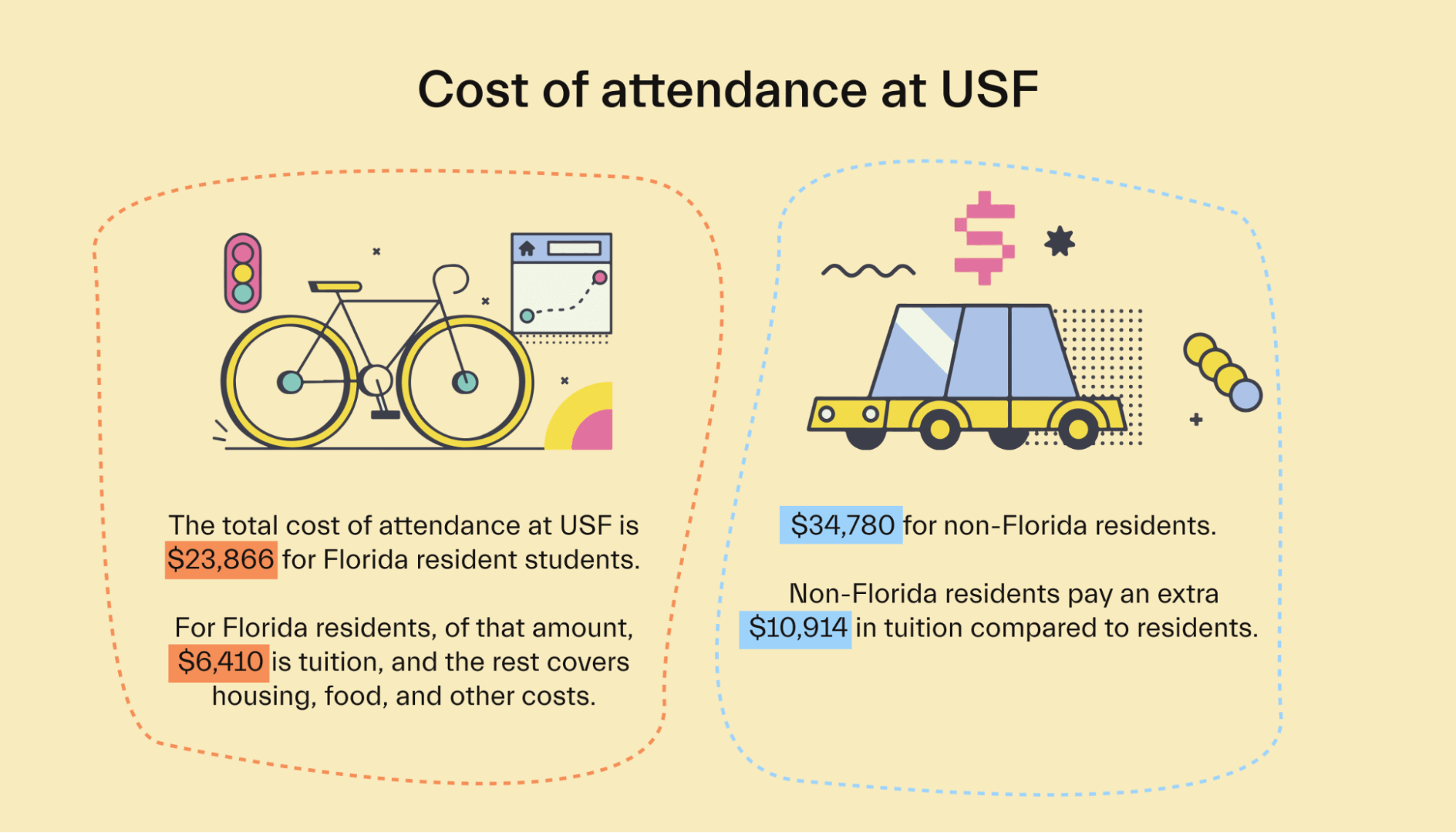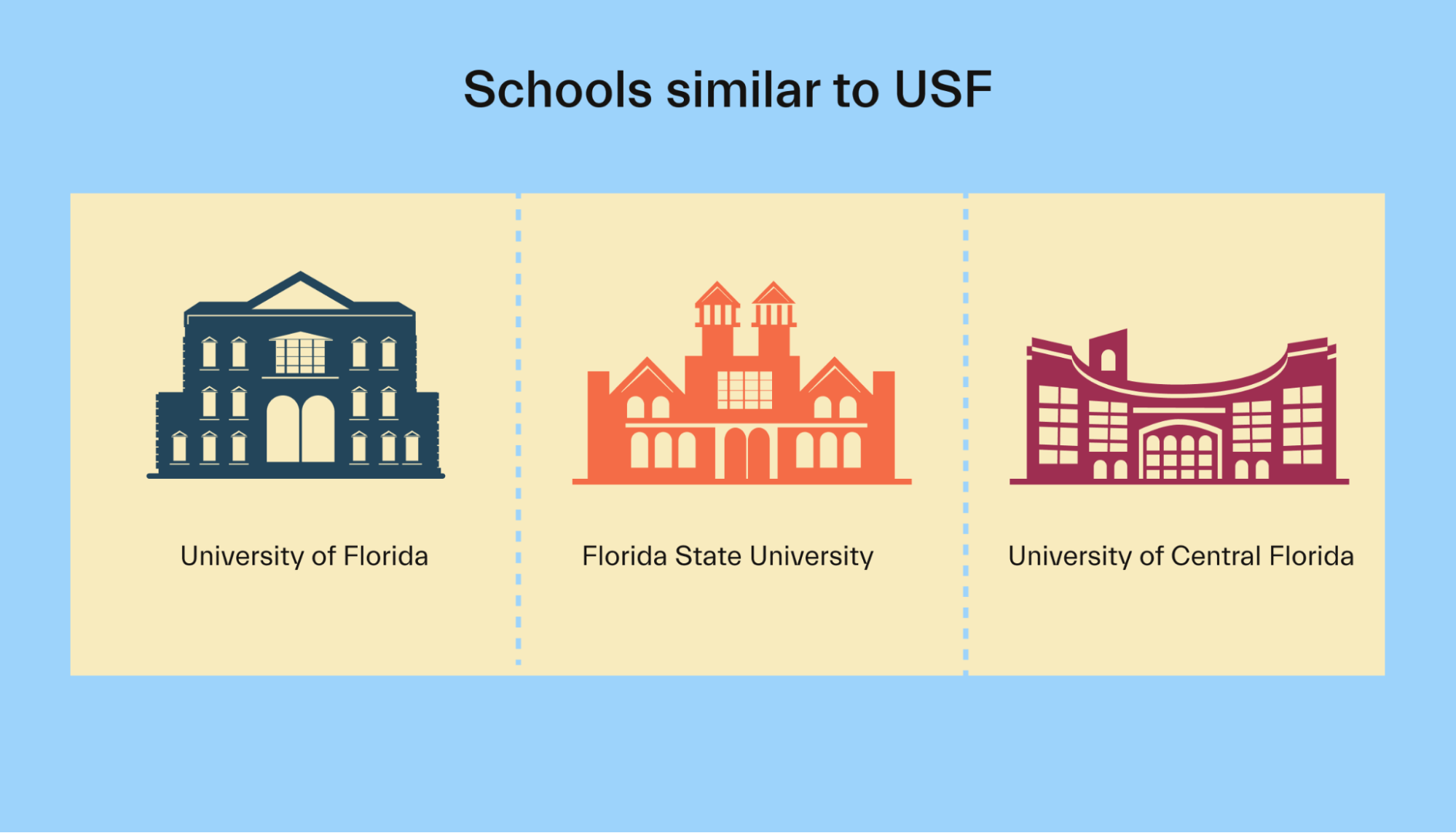Financial aid •
November 11, 2022
University of South Florida financial aid: a complete guide
Learn about financial aid at the University of South Florida, including information about scholarships, loans, and grants.

The University of South Florida, located in the Tampa Bay region of Florida, was founded in 1956. Despite its relatively young age, the University has rich traditions of access and opportunity for students and community service.
The school is home to a diverse student population of more than 45,000 undergraduate and graduate students from across the world! It’s made a name for itself in the more than half-century since its founding and is one of the fastest-rising universities in the US according to popular school rankings.
If you’re a potential USF student but are wondering how you’ll pay to attend, here’s everything you need to know.
A snapshot look at the University of South Florida
The University of South Florida is a research university in the Tampa Bay region. It’s one of the top research schools when it comes to generating new patents, with more than 123 utility patents awarded in 2020. This places it 8th in the US and 15th in the world!
USF is a diverse school with more than 40% of its students being African American, American Indian, Asian, Hispanic, Native Hawaiian or other Pacific Islander, or multiracial. More than 145 countries are represented among the student population. The school places emphasis on creating a more just society and is involved in research surrounding racism and systemic inequality.
The school is composed of multiple colleges, including the colleges of Arts, Arts and Sciences, Behavioral and Community Sciences, Business, Education, Engineering, Global Sustainability, Marine Science, Medicine, Nursing, Pharmacy, and Public Health. Students can choose from more than 100 degree and certificate programs across the colleges.
Outside of class, students can join more than 600 clubs or other organizations, participate in one of the 19 varsity sports or 50 intramural sports, or attend concerts, celebrity lectures, or other events.
Ranking: 103rd nationally
Size: 43,846
Demographics: 44% male, 56% female
Tuition: $6,410 for in-state students, $17,324 for out-of-state students
Acceptance rate: 43%
Average GPA of accepted student: 3.8
Key dates and deadlines (2022):
Application: April 1
Financial aid deadlines: June 30
A look at scholarships offered by the University of South Florida
One of the best ways to pay for college is through a scholarship. Unlike student loans, where you borrow money and pay it back later on, scholarships are simply free money that you can use to pay for educational expenses.
USF’s financial aid website includes a full list of the different scholarship programs it offers. For example, the USF Foundation Scholarships award more than $7 million in aid each year, with awards ranging from $250 to the full cost of attending USF! The Bright Futures scholarship is specifically for students from Florida and is awarded based on their academic performance in high school.
Some of USF’s scholarships are need-based, while others are merit-based. Either way, it’s easy to apply through USF’s online scholarship portal. You can find scholarships that you might be eligible for and submit an application online.
Outside of those provided by USF, you can apply for scholarships from other organizations or even businesses. Many community groups, companies, and other entities operate scholarship programs that give awards small and large. If you look carefully, you can find scholarships for almost everything you can think of!
For more on which scholarships you can apply for and how Mos can help, check out our financial aid tips and tricks.
Student loans
If, after you’ve earned some scholarships, you can’t afford to pay for the rest of your education out of pocket, you can look into taking out student loans.
When you get a student loan, you’re borrowing money from someone to invest in yourself. However, keep in mind that you’ll have to pay back the money that you borrow, plus interest.
USF’s website has a quick breakdown of the different loan programs that students can take advantage of.
In general, the best loan program available to students is the Federal Direct Loan Program. These loans are student loans directly from the US federal government. The government offers 2 types of loans: subsidized loans and unsubsidized loans.
When you get a subsidized loan, interest won’t start building up until after you’ve left college. That makes the loan less expensive than an unsubsidized loan, where interest starts building up right away.
Another perk of both types of federal loans is that they’re eligible for programs like income-based repayment and loan forgiveness, which can help make it easier to pay off your student loans once you graduate.
If your federal loans aren't enough to cover the rest of your college bill, you can also turn to private student loans.
The drawback of private student lenders is that they tend to charge much higher rates and fees than the government. This makes private loans cost far more. They also don’t offer the same benefits, such as income-based repayment. However, you may be able to use these funds for some personal expenses that federal loans won’t cover, such as travel to and from school. That means you should generally max out your federal loans before considering private student lenders.
For more on student loans, check out our article on how student loans work.
FAFSA
Filling out the Free Application for Federal Student Aid (FAFSA) is the most important thing a student can do to help pay for college.
The FAFSA is a universal student aid application that is used by many schools as well as the government. The information you include on your FAFSA can help make you eligible for scholarships, grants, and other aid programs!
Filling out the FAFSA means sitting down with your parents or guardians and entering some personal financial information. You’ll be asked about things like your family’s income and how much money you’ve saved for college.
Based on your answers, the government calculates your expected family contribution (EFC) to the cost of college.
Schools like USF and the federal government use your EFC to determine how much need-based aid you should receive. This can include things like the Pell Grant and scholarships. Your FAFSA also influences the amount you can borrow from federal student loans.
Schools don’t look at the FAFSA when making admissions decisions, so if you’re worried about filling it out and hurting your chances of getting into USF, you don’t have to be.
The FAFSA process starts on October 1 for financial aid awarded during the next academic year. You can submit the form anytime up to the end of June of the year you actually attend school. However, Florida has a May 15 deadline, so you should submit the form as soon as you can!

For more information on the FAFSA and its deadlines, you can visit our article that covers everything you need to know about the FAFSA.
University of South Florida financial aid FAQs
These are some of the most frequently asked questions about financial aid at USF.
What is the University of South Florida’s cost of attendance?
As a state school, the cost of tuition at USF is pretty affordable.

The total cost of attendance at USF is $23,866 for Florida resident students and $34,780 for non-Florida residents. For Florida residents, of that amount, $6,410 is tuition, and the rest covers housing, food, and other costs. Non-Florida residents pay an extra $10,914 in tuition compared to residents. Out-of-state students may also face other costs, such as transportation, that can increase the cost of going to the school. They also won’t be able to live with local families, which some USF students may do to help cut down on living expenses.
How many students pay no tuition at USF?
USF does not publish how many students get a full ride at the school. The average aid awarded to a first-year student in 2019 was $10,039, with 53% of first-year students receiving need-based aid.
Overall, USF usually meets 57% of its students' financial needs.
Can out-of-state students receive financial aid?
Yes, out-of-state students are eligible to receive financial aid at USF. As a state school, USF primarily looks to serve students from Florida, which is why it offers discounted tuition to resident students. However, out-of-state students can still qualify for need and merit-based aid at the school, whether it’s awarded by the government or USF itself.
Can I establish residency for tuition purposes?
To qualify for the lowest tuition rate at USF, you must qualify as a Florida resident. To qualify, you must meet these requirements:
Be a US citizen, permanent resident alien, or a legal alien granted indefinite stay.
Maintain a legal Florida residence for at least 12 months prior to the start of the semester.
Reside permanently in Florida and establish legal domicile
Demonstrate an absence of ties to other states
Simply going to school or living in Florida does not make you a resident and eligible for the most affordable tuition rates.
You can request a reclassification of your residency status with the Registrar if your residency changes and you want to be seen as a resident for tuition purposes.
Can international students qualify for financial aid?
Yes, an international student is eligible to receive scholarships and other financial aid at USF. However, they will pay higher tuition fees due to not being a resident and cannot receive federal aid such as Stafford loans.
Universities like the University of South Florida that you might be interested in
If you’re looking for a good school in Florida but don’t think USF is the right choice for you, consider these alternatives.

University of Florida
Located in Gainesville, Florida, the University of Florida is one of the largest public universities in the state. The school is selective, with an average GPA of 4.5 and an average SAT score of 1405 for its 2020 class.
If you want to attend a top university that charges reasonable tuition, the University of Florida might be a good fit for you.
Florida State University
Located in Tallahassee, Florida State University is the oldest continuous site of higher education in the state.
Like USF, FSU is selective with a 4.0-4.4 average GPA and 1230-1350 average SAT for its 2020 first-year class. Students can choose from one of the school’s 276 different programs.
If a school with history and a reasonable price tag appeals to you, FSU might be the right choice for you.
University of Central Florida
The University of Central Florida is a younger school. Founded in 1963 and located in Orlando, it provides a more metropolitan experience than some other schools in Florida.
UCF is focused on research and has a diverse student body, as 49.1% of students are minorities. In addition, 57% of first-time-in-college students graduate with no educational debt!
Conclusion
The University of South Florida is an exciting, growing school that offers students the opportunity to attend a high-quality research institution and receive a world-class education at a low cost. If you’re interested in research but don’t want to pay the high costs of a private university, USF may be a good fit for you!
With Mos, you get access to the largest scholarship pool in America. Get started today!
Let's get
your money
- Get paired with a financial aid expert
- Get more money for school
- Get more time to do you







